Venomous snakes live worldwide and come in a huge variety of species. While only 7% of all snake species are venomous, the small minority of these reptiles have earned a bad name for the rest of the nearly 3,500 other species. Understanding snakes, even venomous ones, is an important part of living with the rest of the animals on earth! Today, we are going to be comparing two of the most common venomous snakes in the world. Let’s discover what makes the cottonmouth and cobra different. Cottonmouth vs Cobra: Comparing Two Venomous Snakes. Let’s begin!
Comparing a Cottonmouth and a Cobra
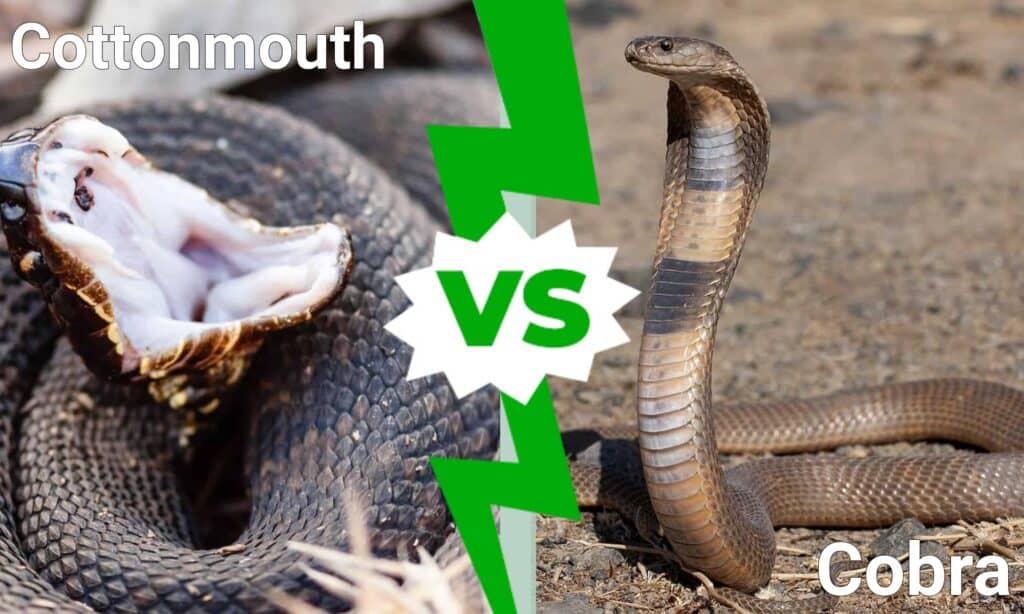
| Cottonmouth | Cobra | |
|---|---|---|
| Taxonomy | Family: Viperidae Genus: Agkistrodon | Family: Elapidae Genus: Naja |
| Size | Length: Up to 4 feet Weight: Up to 3 pounds | Length: 6-10 feet Weight: Depends on the species |
| Hoods | No hoods | Flatten necks to create famous “hoods” |
| Venom | Cytotoxic venom. LD50 kill value of 25.8 mg/kg subcutaneous. | Neurotoxic and occasionally cytotoxic venom. LD50 kill value of .09-.21 mg/kg subcutaneous. |
| Distribution | Southeastern United States. | Africa through Asia. |
| Defense Posturing | Coiled mass while flashing white mouths. | Elevated body posture and flattened hood. |
The 6 main differences between a Cottonmouth and a Cobra
The main differences between a cottonmouth and a cobra are their size, venom, and distribution.
Cottonmouths and cobras are widely regarded as dangerous snakes, although they have widely disparate ranges and wouldn’t ever meet naturally. Although they are both venomous snakes, they aren’t closely related to one another. Cottonmouths belong to a group known as the “pit vipers” in North America, including the copperhead and all rattlesnake species. On the other hand, cobras belong to the Elapidae family and are more closely related to sea snakes and coral snakes. To be classified as a “true cobra,” a snake must belong to the Naja genus.
Both snakes are large, just in different ways. Cottonmouths are the smaller of the two but are significantly thicker than cobras. They rarely grow past 3 feet but are pretty stout and flat. Cobras are extremely long and slender snakes. Most species of cobra can grow over 6 feet, with many species able to reach 10 feet with regularity.
Although both snakes are venomous, cottonmouths are significantly less dangerous than even the least dangerous of all cobra species. Between the three common venomous snakes in the US, cottonmouths usually rank second, between the less dangerous copperhead and the famously deadly rattlesnake.
Let’s take a deeper look at these differences, plus a few more, below!
Cottonmouth vs Cobra: Taxonomy

Cottonmouths are vipers, while true cobras belong to the Naja genus.
©iStock.com/Saddako
All snakes share a common ancestor, but the cottonmouth and the cobra still aren’t as closely related as some other snakes are. Cottonmouths belong to the Viperidae family, classifying them as vipers. Vipers live almost everywhere on earth and are famous for their venom. More specifically, cottonmouths are members of the Agkistrodon genus, otherwise known as American moccasins or American pit vipers. The other pit vipers related to the cottonmouth include copperheads and all species of rattlesnake. Incredibly, there are over 50 common names that the two species of cottonmouth go by.
“Cobra” is a commonly used term for many different snakes, but only members of the Naja genus are classified as “true” cobras. The famous King cobra, for example, isn’t actually a cobra belonging to the Naja genus, although it carries the common name “cobra.” Altogether, there are about 38 species of snake classified as true cobras, although revisions are still underway in the literature.
Cottonmouth vs Cobra: Size
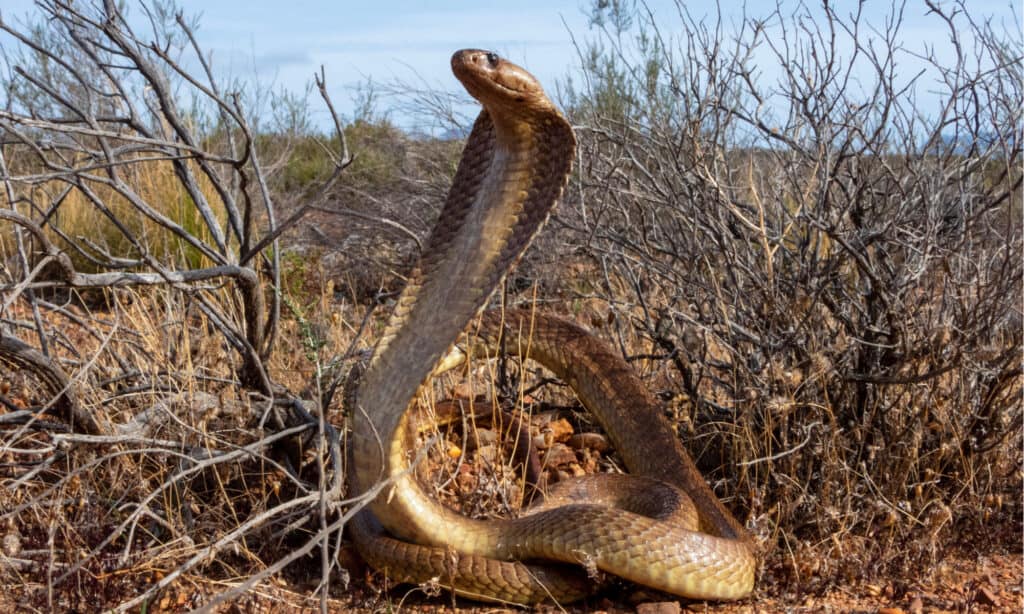
Cobras are quite a bit larger than cottonmouths.
©Willem Van Zyl/Shutterstock.com
Cottonmouths are smaller than the average cobra but generally aren’t considered to be small snakes. They rarely grow over 3 feet but are extremely thick and stocky in their build.
Cobras are extremely long snakes but are much slenderer than cottonmouths. Most cobras grow to 6 feet, with certain species regularly growing over 10 feet long.
Cottonmouth vs Cobra: Hoods
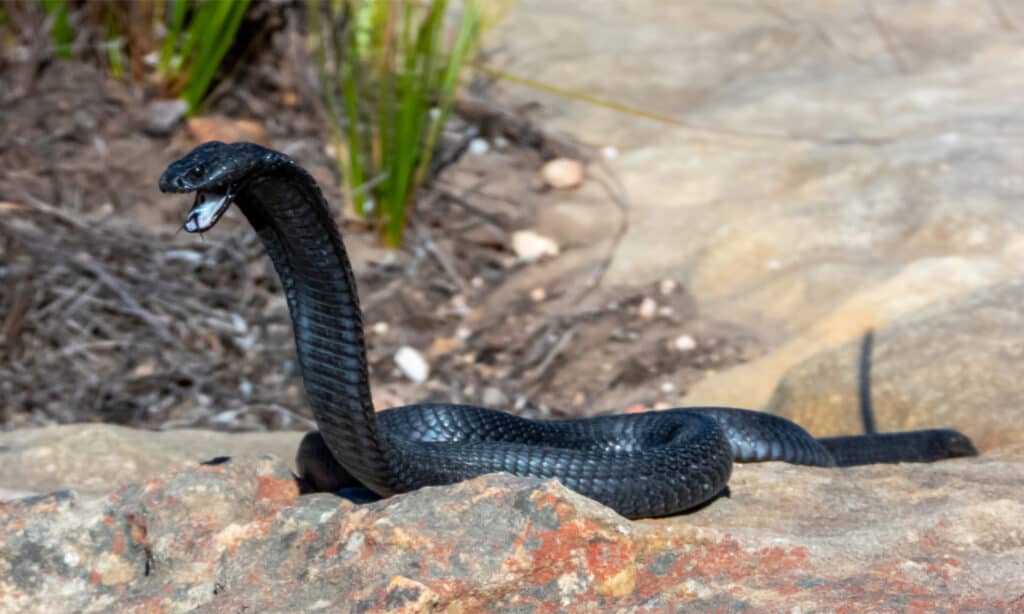
Cobras are famous for their flattened necks and hoods.
©iStock.com/Willem Van Zyl
Cottonmouths don’t have hoods, but cobras do. Their “hoods” are usually a response to a potential threat and are one of the distinctive characteristics of cobras. When a cobra feels threatened, it will flatten its neck in order to make itself look larger.
Cottonmouth vs Cobra: Venom
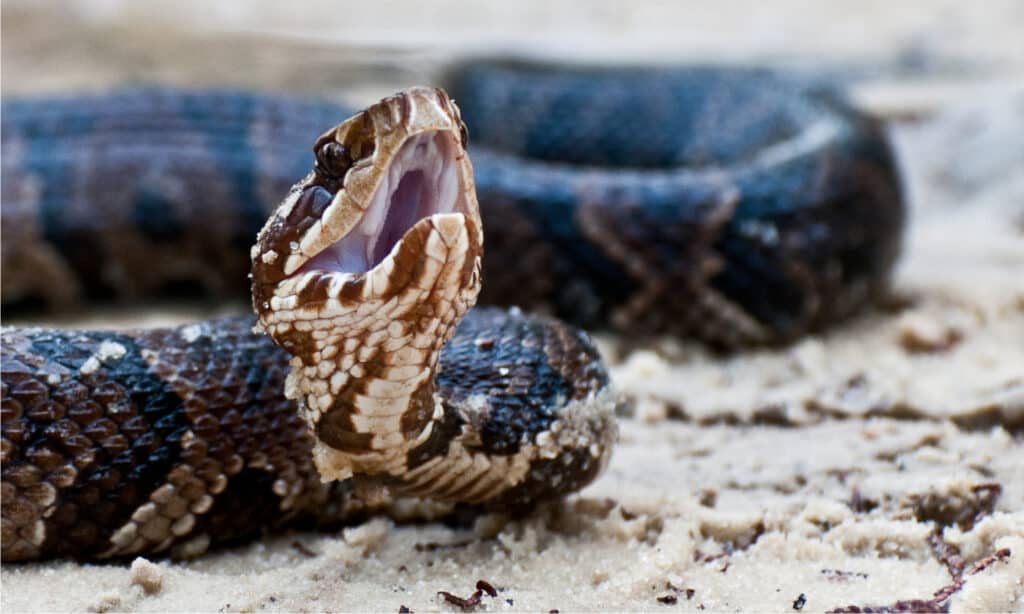
Cobras are significantly more dangerous than cottonmouths.
©Jay Ondreicka/Shutterstock.com
Cottonmouths are highly venomous snakes but rarely fatal. They are known for their cytotoxic venom that damages tissue in the local region. Occasionally, untreated bites result in amputation, with fatal bites exceedingly rare. Cottonmouths have an LD50 kill value (LD50 represents the amount of venom to kill 50% of test animals) of 25.8 mg/kg if injected subcutaneously.
Cobras have varying levels of venom toxicity across the various species, but overall, cobras are among the most dangerous snakes in the world. The most dangerous cobra is the Caspian cobra, with an LD50 of 0.1 mg/kg if injected just under the skin.
Cottonmouth vs Cobra: Distribution

Cottonmouths only live in the southeastern United States. Cobras live in Africa and across most of Asia.
©reptiles4all/Shutterstock.com
The cottonmouth is exclusively found in the southeastern region of the United States. Their range extends along the east coast into Virginia and Maryland and as far west as central Texas.
Cobras are much more widely distributed than cottonmouths. They can be found across southern Africa, most of Asia, and Indonesia.
Cottonmouth vs Cobra: Defense posturing
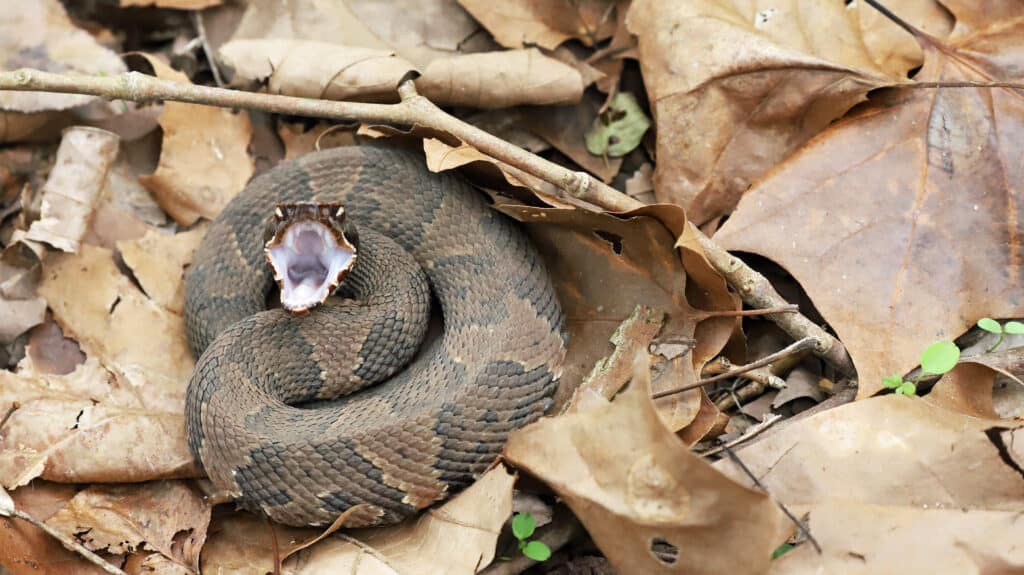
Both the cottonmouth and the cobra have unique defensive postures.
©KF2017/Shutterstock.com
The defense posturing of a cottonmouth is what gives its famous name. When threatened, cottonmouths coil up and display their bright white mouths, hence the name “cottonmouth.”
Cobras also have a famous posture, one that gives them their famous hoods. When threatened, they flatten their necks in order to look larger and potentially scare away predators. At the same time, they raise a quarter of their bodies in the air in the “snake charmer” position. In some species, this behavior allows them to effectively spit poison into the eyes of a threat.
The photo featured at the top of this post is © Nathan A Shepard/Shutterstock.com
Discover the "Monster" Snake 5X Bigger than an Anaconda
Every day A-Z Animals sends out some of the most incredible facts in the world from our free newsletter. Want to discover the 10 most beautiful snakes in the world, a "snake island" where you're never more than 3 feet from danger, or a "monster" snake 5X larger than an anaconda? Then sign up right now and you'll start receiving our daily newsletter absolutely free.
Thank you for reading! Have some feedback for us? Contact the AZ Animals editorial team.






